The Recognition Engine: Why clarity alone won’t get you known, and how the MP3 Framework makes your message land
This works for every solopreneur B2B services business we’ve ever coached.
Welcome to How Solos Scale. Each week, we share a new framework, concept, or example of how solopreneurs are scaling from $25,000 to $50,000+ per month.
Hey there,
In The Recognition Gap, we introduced the CP3 Framework as the foundation of a scalable solo business.
When you get clear on the problem you solve, the person you solve it for, and the process you use to solve it, everything starts to snap into place.
Your offer sharpens.
Your sales pitch gets tighter.
Your point of view becomes easier to articulate.
But clarity alone doesn’t close the gap.
You can know exactly what you do, and still struggle to become known for it.
This is another place where solopreneurs get stuck.
When Nick started his coaching business, he had clarity.
He thought the biggest reason solopreneurs failed was they didn’t "niche down." He built his whole content strategy around it. The problem was clear, the person was clear, the process was clear. But when he started publishing, his posts about “niching down” didn’t resonate.
Three months in, he wrote a post called "3 reasons service-based solopreneurs fail and get another job."
No market niche.
No service method.
No core message.
Nick was sure #1 was the headline problem.
When the comments rolled in, everyone pointed to #2. Niching down wasn’t the problem holding people back. The real pain was not having a clear service method.
That post changed everything.
Nick reframed the problem from “niching down” to “building offers.” He had the same expertise and process, just different framing. But the market leaned in. Prospects said, “Yes, that’s me.” Conversations turned into clients.
The clarity of CP3 gave Nick a foundation.
But the repetition, publishing, and feedback loop of MP3 revealed what actually resonated.
Resonance requires saying the same thing, in different ways, in public, over time, in front of the people you’re trying to reach, until you get signal.
Once you have clarity from CP3, the next question is always the same:
“Okay… so what do I say?”
You might be clear behind the scenes, but it's easy to revert to surface-level content when it’s time to publish, pitch, or package up what you do in a scalable way. You share generic tips. Random stories. Thought leadership that doesn’t lead to more leads.
This might seem like a content problem, but it's really a connection problem.
The content doesn’t point back to a problem, a process, or a proof point. So it doesn’t drive inbound, earn trust at scale, or get your name passed around in high-trust circles. For that, you need to consistently show up with content that creates signal.
That's where the MP3 Framework comes in.
Let’s break it down.
MP3 Framework: Market The Problem. Market The Process. Market The Proof.
The MP3 framework is the simplest yet most powerful approach to content strategy.
A content strategy, in its most basic form, answers the question: What do I write about?
We’ve created the MP3 Framework to help you answer this question as directly as possible.
Treat this framework as a lens—a way to think about how you share what you do with the world. Because if you want to be remembered, trusted, and hired, you need to do three things consistently:
Market the Problem to show you understand their pain better than they do.
Market the Process to show you’ve solved it before with a repeatable method.
Market the Proof to show your results speak for themselves.
When you consistently publish content across these three areas, you create demand and build belief. Your business builds gravity. You stop chasing clients, and they start coming to you.
MP3 works for every solopreneur B2B services business we’ve ever coached.
We built MP3 because solopreneurs needed a simple, repeatable system to communicate their value—without turning into full-time content creators or reinventing the wheel every time they post.
This isn’t a hack or a marketing ploy.
It’s a way to show up consistently with content that’s directly tied to how you help people, so you stay visible, credible, and relevant in the places that matter most.
It works even if your audience is small.
It works even if you only publish a few times a week.
It works even if you hate the idea of content strategy.
It works whether you sell strategy, ops, marketing, design, or any type of consulting/advisory services.
We know because we use MP3 for ourselves and for our clients to consistently attract aligned clients, without feeling like we're auditioning on LinkedIn every week. Used well, MP3 becomes the engine behind everything you publish, pitch, and promote.
Now, let's walk you through each part of the framework so you can start applying it.
Market the Problem: Articulate The Emotion Behind The Problem
Problems are universal.
We all have them. We all want to solve them. Most importantly, we're all willing to pay to make them go away. But nobody wakes up thinking: "I really need to implement a robust content strategy with clearly defined problems today!"
Instead, you wonder:
"Why isn't anyone engaging with my posts?"
"Why do I keep attracting the wrong clients?"
"Why can't I seem to make consistent income?"
"Why does my expertise feel scattered everywhere?"
"Why do experts keep telling me to do sh*t that doesn't work for me?"
When you market the problem, you're meeting people exactly where they are—in their struggles, frustration, and "I'm so done with this" moments. You reflect their confusion back to them. You give them language for the friction they feel but can’t explain.
Here's why this approach is so damn powerful:
1. It creates magnetic resonance.
Marketing the problem meets people in the middle of their mess.
When you articulate someone’s problem better than they can, they can’t look away. That “holy sh*t, are you in my head?” moment is no coincidence. It's problem articulation at work.
And it usually gets comments like this:
2. It builds trust.
When you describe someone's problem, they automatically assume you know how to solve it.
It's easier to write content like this when you've experienced the problem yourself. But if you haven't, you can borrow the experiences from clients and peers.
For example, Nick's experienced some (but not all) of the limiting beliefs he listed in this post.
But his clients describe these beliefs to him all the time, so he's borrowing from their experiences to articulate their problems back to them.
3. It keeps your strategy fluid.
Your problems, and your point of view on them, aren’t static. They evolve as you do more reps, work with more clients, and sharpen your expertise.
If your content doesn’t change over time, you’re not paying attention to signals.
Take Erica as an example. When she left her Head of Content role in 2023, she thought content was everything. She built her career on words: editing, writing, publishing. But running her own business forced a hard truth:
Content means nothing without all the other pieces that make it work.
Inside a company, she didn’t feel the pain directly if content underperformed. As a solo, every word either pulled clients closer or pushed them away. As a result, she's reframed how she thinks about content. It’s not just “strategy + execution = results.” It’s messier. It’s more dynamic and nuanced. The pieces are always moving.
The moment you treat content as fixed, you stop seeing the shifts in the market and in yourself.
With the MP3 Framework, you’re not “locked in.” You’re dialed in. Staying dialed in means letting your strategy shift as your perspective changes.
4. It makes you more believable.
When you focus on problems, you can't hide behind jargon.
You have to get specific about what's actually not working and why. This forces you to stay connected to real people with real problems—not theoretical ideal clients with theoretical ideal problems.
The best part about marketing the problem?
Problems are everywhere.
Your clients are telling you about them every day. Your sales calls are absolutely packed with them. Your LinkedIn feed is full of people describing them. Your DMs probably have a few sitting there right now.
You just need to learn to spot them, articulate them clearly, and connect them to your solution.
Also, AI is here. If real experiences aren't part of your content mix, you're going to have a way harder time passing the BS test in your content.
Here’s how to start building problem-first content:
A great problem is about being useful.
It gives people language they didn’t have. It articulates something they’ve felt but couldn’t explain. And it helps them make a confident decision: “This is what I need. You’re who I want to work with.”
Look for the problem behind the problem.
Start by asking:
What are your clients really struggling with beneath the surface?
What myths or “best practices” are keeping them stuck?
What’s the hidden cost of staying stuck?
What are they doing that looks productive but is actually a bandaid?
What future are they headed toward if nothing changes?
Then, go five layers deeper. Get beneath the symptom.
Here’s a simple example:
Surface problem: “My ideal client is frustrated that nobody’s engaging with their content.”
Five layers deeper:
Because their ideas aren’t tied to a problem people actually want solved.
Because they’re trying to sound smart instead of being helpful.
Because their point of view is vague, not sharp.
Because they’re afraid to repeat themselves.
Because they don’t know what they want to be known for.
Root problem: They’re unclear on what problem they solve, who it’s for, and how to talk about it repeatedly in public.
That’s your content.
Turn it into a post. Turn it into five posts. Turn it into a newsletter.
Here’s an example of how Erica spoke to that exact problem in her content:
That’s how you get recognized, build trust, and make your expertise visible. Because when you articulate someone's struggles better than they can themselves, they believe you must know how to solve them. You’re not trying to prove how smart you are. You’re trying to show people you understand their pain.
There are endless ways to market the problem, just like there are endless ways to create a narrative.
For simplicity's sake, here are our favorite 7 prompts.
1. Name silent struggles out loud.
These are the thoughts your buyers have but rarely say out loud.
This approach validates the inner dialogue all of us have when faced with challenges. For example, in Erica’s post above, she’s validating the fact that our desire to appear competent as solos (“we can do everything!”) tends to override our ability to win mindshare.
Most solos might not even know that. They feel the pain, but struggle to articulate why it’s a problem.
Just like Erica didn’t realize, for years, that her relationship with content was incomplete. She thought words were everything. Until running her own business forced the painful truth that words mean nothing unless all the other pieces are in place.
Naming silent struggles is huge because it gives people a safe space to have big a-ha lightbulb holy sh*t wtf moments. Once you see it, you can't unsee it...(which means change is soon to follow).
2. Challenge accepted wisdom.
These are industry assumptions that might actually be hurting people.
Here, you question the "best practices" mindset itself. Point out where conventional advice fails. Why do we treat other people's success stories as blueprints?
This can explore how an obsession with proven paths actually stifles innovation. The conventional wisdom of "follow what works" might be the very thing preventing growth.
Brendan Hufford comes top of mind when we think of this. He's out there all day, every day making you rethink your marketing playbooks because it could lead to "checkbox marketing" (a phrase he repeats over and over).
His content is fiery, but it works because we're all more innovative when we challenge accepted wisdom.
3. Point out hidden costs.
Show the real price of staying stuck. Not just the obvious costs but the downstream effects people haven’t considered.
Here, you can explore the cascading effects of avoiding experimentation. Go beyond missed opportunities to the painful, unseen costs of declining creativity, diminishing competitive advantage, and the gradual loss of problem-solving muscles.
You want to show how playing it safe actually makes people less secure over time.
In this example, our friend Brian is calling out the unseen costs of running strong ads on top of a broken demand gen foundation.
Status quo: “Good ads will fix our lead problem.”
Brian’s take: “Good ads won’t work if your entire system is broken. In fact, good ads usually reveal the issues.”
Status quo response: “Hire more agencies to fix the issue.”
Brian’s take: “More agencies will make the issue worse, and here’s why.”
So think: What are the hidden costs your clients face?
Share powerful questions and powerful answers that help potential clients see the blind spots in status quo “solutions”.
4. Identify false solutions
Name what they’ve already tried and explain why those attempts failed. Show what’s missing from common approaches.
This is when you examine why following “standard frameworks" and “playbooks” often fails. Focus on how these solutions address symptoms (lack of ideas) rather than root causes (fear of meaningful experimentation).
What are your clients doing that they think is helping them, but is really more like a bandaid, so they don't have to look at the blood?
Call those out, like Taylor does in this post.
5. Blatantly articulate root causes.
Go beyond surface symptoms to reveal underlying patterns. Connect seemingly unrelated problems.
This approach would connect the dots between seemingly separate problems, for example:
Why content feels shallow
Why innovation feels risky
Why best practices fail
The narrative reveals how all these stem from the same root: no systematic way to learn from experimentation.
For example, a former client in the retail space has a unique vantage point on a big problem. There’s a massive disconnect between what corporate thinks the problems with disengaged stores are and what the actual problems are.
Bekki sees it plain as day because she's been on both sides.
What have you seen from being on both sides?
What do you get that certain ideal clients just don't (yet)?
6. Frame future implications.
Show where the current path leads. Help people see the growing costs of inaction.
Paint the widening gap between those who can turn experiments into insights and those who can't. This narrative shows how the ability to learn from experimentation will become increasingly crucial for business survival.
AI is a hot topic for future implications so it's top of mind.
On one side we've got the: "Is AI going to take your job? No, but...you'll probably fall behind if you don't use it."
And on another, we've got the: "AI is the worst thing to ever happen to our environment and the human race as we know it. Are we all insane?!"
Those two personas have very different values and audiences.
What are your values? What does your audience value? What are your perspectives?
Frame them up.
Here’s an example of how you can do that in real-time, even as your opinions are evolving:
7. Create permission.
Give people space to admit struggles. Normalize common challenges. Remove shame from difficulties.
This narrative normalizes the messiness of real innovation. Instead of shaming people for following best practices, we acknowledge why it feels safer and create space for a new perspective.
You're giving them permission to make experimentation feel accessible rather than scary.
We do this on our Duo Consulting landing page.
First, we name the problems (your expertise is your biggest asset and your biggest roadblock).
Then, we imply feeling these problems is normal (the hardest part isn't your capability).
Then, we give you permission to channel your expertise towards a specific offer, rather than simply choosing "one thing to focus on", which feels hard, and sad, and scary, and wrong.
Let's pull this all together:
Here’s a simple checklist for creating problem-first content:
Choose one problem element to focus on. Don’t try to tackle everything at once. Pick one angle and do it justice.
Pick a specific example. The more specific you get, the more it resonates. Generic problems get generic engagement.
Express empathy. Make them feel seen and heard before you try to help. Phrases like "I get it" and "It's not your fault" go a long way.
Validate the problem with experiences and data. Show you understand through examples, patterns, data, and experiences.
Show you understand the deeper implications. Go beyond surface level. Connect dots others miss.
End with hope. Show or imply there is a better way. Help them come to the conclusion that they do not need to stay stuck.
Onto the next step.
Market the Process: Turn your experience into valuable insights
If marketing the problem is about reflecting someone’s experience back to them, marketing the process is about showing them how you think through it.
This is where most people freeze.
Because they assume “talking about your process” means giving everything away. Or that it requires a perfect, polished framework. Or that no one will care how the sausage gets made.
Not true.
You don’t need a trademarked acronym or an illustrated map of your method.
You need to show the thinking behind your work.
How you diagnose
How you make decisions
How you prioritize, guide, simplify, and repeat
We're talking about going way beyond "winning in public" (which is what most people who "build in public" actually do). The messy ups, downs, wins, failures, unfinished thought processes, unexpected roadblocks, thought evolutions, and everything in between is how you connect with others and slingshot credibility.
It’s not about oversharing or turning everything into a teaching moment.
It’s about showing your thinking, choices, and results so people know exactly what they’re getting if they work with you.
That’s why we document our journey, like this post where Erica shares the Duo Consulting launch:
Why sharing your process matters:
When we say "process," we're talking about two things:
Your process: The behind-the-scenes of how you work, think, and arrive at your unique insights. The real, raw, human stuff.
Their process: The process you take your clients through. What brought them to you, what it looks like working with you, how they progress throughout, and all that tangible stuff.
This way, you're showing how you work and also what it’s like to work with you. Because people don’t just buy the outcome. They buy into how you get there—and whether it aligns with how they think.
Here's why it makes a difference:
1. It creates contrast.
Most service providers sound the same.
“Done-for-you content that converts.”
“Marketing strategy that drives results.”
“Helping you scale faster.”
Cool. What makes you different?
Your process is the answer.
The way you solve the problem is just as important as the problem itself. It’s how people self-select. It’s how you make the invisible visible. And it's how you stand out from everyone selling the same category of results.
Share your thinking, not just your offer.
2. It makes your offer make sense.
Clients don’t buy ambiguous magic.
They need to see some logic. Not every detail, just enough shape. Your process content connects the dots between the problem you’ve described and the offer you’re selling.
It turns your work from mystery into method.
3. It builds buy-in early.
The more someone sees your process in public, the less they need to be “sold” in private.
If they’ve watched you unpack your thinking 10 different ways on LinkedIn, they’ll show up to your intro call 80% bought in.
What counts as “process” content?
This is where most people get tripped up. You don’t need a linear 6-step formula. You just need to document what you do (or how you think) in ways that make your approach feel:
Thoughtful
Repeatable
Trustworthy
Like this honest take from Taylor Bogar:
Here are 7 easy ways to create “Market the Process” content:
1. Show your decision filters
Example: “Here’s how I evaluate if a founder has a solopreneur business worth scaling.”
This helps people understand your standards and see how they measure up.
2. Share “how I think about X” posts
Example: “How to think about choosing a lead magnet when you don’t have a funnel.”
These aren’t how-tos. They’re how-you-thinks.
3. Break down your internal questions
Example: “When I’m building a client’s offer, I always ask this first…”
This helps your audience self-reflect and signals expertise without oversharing.
4. Contrast your approach with others
Example: “Why I don’t believe in 90-day content plans and what I recommend instead.”
This sharpens your problem and point of view, and builds a sense of “this person gets it.”
5. Open-source a small piece of your process
Example: “Here’s my 3-question checklist for deciding if an offer is niche enough.”
You’re giving value while reinforcing your larger method.
6. Debrief a client insight or turning point
Example: “On a call yesterday, a founder said something that stopped me cold…”
This creates a narrative while reinforcing how you help people get unstuck.
7. Share your experiments (and lessons)
Example: “I tried repositioning a client’s offer from X to Y. Here’s what worked, what didn’t, and what I’d do differently.”
Now you’re teaching without teaching and demonstrating your learning loop.
Marketing the process shows you’ve thought it through.
Your approach isn’t random.
Working with you means stepping into something structured, even if the structure is flexible.
Nobody can replicate your experience. Nobody can copy your real-world lessons. Nobody can steal the magic that happens inside your program.
So show it.
A few ways to document your journey:
Offer evolution: How your service or program has changed and why.
Pricing changes: Why you raised rates, adjusted your model, or changed terms — and what you learned.
Firsts and milestones: Your first client, first group program, or first $10k month — and how you got there.
Lessons from losses: Failed launches, bad fits, or services you retired — and why.
Behind the scenes of a decision: Explain why you stopped offering a service or pivoted your ICP.
Pivots & experiments: What happened when you tested something new — like a pricing model or launch style.
Client feedback that changed you: Share a piece of feedback that reshaped your process or offer.
Client experiments: Share what they tried, what worked (or didn’t), and how you helped them course-correct.
Pivots they made with your help: How your coaching led to a change in their offer, positioning, or content strategy.
A few ways to document your frameworks and systems:
Signature frameworks: Your models or methods for solving problems.
Checklists and templates: Tools you use — like your content planning checklist or offer creation template.
Workflows & SOPs: How you run a client call, review content, or onboard new clients.
Decision frameworks: How you evaluate clients, pricing, or which projects to prioritize.
Toolkits & resources: The tools you swear by and how they fit into your process.
Training materials: Share course modules, playbooks, or slide decks you’ve built for clients (anonymized or hypothetical, need be).
System updates: How your internal processes have changed over time.
You don’t need to tell them every detail. But you do need to help them feel confident that you have a map. And that the map will get them where they want to go. This is how you earn trust before the sales call. It’s how you position your offer without pitching it. It’s how you build signal that leads to scale.
Recognition is about being known for a problem and being known for how you solve it.
Next up, how to prove it.
Market the Proof: Prove that transformation is possible
“But will it work for me?”
That’s the question behind every prospect lurker, lead, and late-night DM.
It’s the doubt hiding behind the compliment. It’s the fear behind the follow. And it’s your job to answer it, before they even ask.
When you market the proof, you’re doing 6 important things:
You build credibility. Anyone can make bold claims. Proof shows receipts.
You validate your approach. It’s not just your process that matters — it’s the outcomes it creates.
You reduce risk. When people see others succeeding with your help, they feel safer stepping forward.
You trigger the “that could be me” effect. The closer your proof matches someone’s current state, the more they believe their transformation is possible.
You justify your pricing. Specific results show your value. Suddenly, your offer looks like a smart investment, not an expensive risk.
You build social trust. We are tribal creatures. We look to others to decide what’s worth it.
Nothing signals “worth it” like real, undeniable, public-facing wins.
Marketing the proof is about showing (not just telling) that what you do works. It builds confidence, reduces risk, and makes the invisible feel tangible. Because in a world full of empty claims and inflated promises, proof is the differentiator.
It's what makes someone go from “That’s cool” to “I’m in.”
5 Ways to Market the Proof
Not all proof is created equal.
Some examples spark immediate belief. Others feel vague, forgettable, or fake.
Here are the five types of proof we use most with clients because they work.
1. Before/After Examples
The human brain is wired to notice contrast.
That’s why weight loss photos work. It’s why home renovation shows always include the “before” tour.
Your business content should work the same way.
A great before/after example does more than show progress. It collapses the timeline. It shows what’s possible in a certain time period. Most importantly, it invites your reader to see themselves in the story.
The structure is simple:
Before = Painful reality
Bridge = Your approach
After = Clear transformation
Here's an example of this in action:
It’s not just about showing growth. It’s about showing change in motion.
2. Specific Results with Numbers
Numbers are sticky, especially when they’re weird, oddly specific, or tied to real-world outcomes.
"10x your revenue” sounds like marketing fluff.
“Went from $4,287 to $47,839 in 5 months” sounds like the truth.
That’s the power of numbers. When you anchor your proof in data, it triggers belief and makes your claims harder to dismiss. It gives people a clear benchmark for what’s possible.
How to make numerical proof actually meaningful:
Use odd, precise numbers: "$9,738 in new sales" feels more believable than "$10,000 in new sales."
Include the full context: "They went from 32 leads per month to 127 leads per month with the same ad spend."
Connect multiple metrics to tell a story: "Email open rates increased from 22% to 38%, click rates from 3% to 9%, and sales from $5K to $15K per month."
Follow the money: Ultimately, show how the numbers affected what people care about most — time, money, impact, or stress.
Always tie the data back to what people care about: time, money, control, confidence, freedom. If the metric doesn’t matter to your ICP, it’s not proof. It’s noise.
3. Screenshot Evidence
In a world of hot takes and hype, screenshots feel like truth serum.
They’re raw. They’re unfiltered. And they’re increasingly non-negotiable.
A screenshot says: “I didn’t make this up. This happened, exactly as you see it. Here’s what they said when I wasn’t asking for feedback.”
The best (and most believable) screenshots are:
Unprompted client messages: When someone DMs you, "HOLY SHIT, THIS WORKED," without you asking for feedback, that spontaneous excitement is pure gold.
Revenue/results dashboards: Nothing proves your approach works like a screenshot of actual analytics showing the upward trend.
Public comments or praise: When someone publicly vouches for you, it carries more weight because they're putting their reputation on the line.
Implementation in action: Showing how clients have applied your framework in the wild proves it's practical, not just theoretical.
Analytics from before/after campaigns: Proof your results match your claims (simple as that).
How to use screenshots most effectively:
Circle or highlight the key data point: Don't make people search for the important part. This is why people annotate screenshots on their LinkedIn posts.
Add context: Sometimes, a brief "This client implemented the framework on Day 1 and sent me this on Day 14" is all you need.
Group related screenshots to tell a story: The message where they were skeptical, followed by the implementation, followed by the results, creates a compelling narrative.
Always get permission: This should go without saying, but don't share private messages without explicit consent.
Just make sure you:
Highlight the part you want people to pay attention to
Add context (“This message came in 14 days after we published her repositioned offer”)
Always get permission
Screenshots work because they show the real time, real person impact of your work.
And unlike testimonials, they shouldn't be over-polished.
4. Client Success Stories
Numbers are powerful, but stories are sticky.
A client success story gives your audience something to look forward to. Results are the goal, but a great journey makes the work worthwhile. That’s why these stories work best when they capture the messy middle.
The doubts. The false starts. The turning points. The internal shifts.
“Yes, the journey is messy, but look at how this person overcame the pain and got through to the other side.”
Here’s the anatomy of a strong client success story:
The Protagonist: A relatable person (someone your buyer can see themselves in).
The Struggle: A problem they couldn’t seem to solve on their own.
The Turning Point: What finally got them unstuck.
The Transformation: The concrete results (time saved, money earned, confidence gained).
The Ripple Effect: What changed in their business or life long after the engagement.
This is what we did with Brian, whose story opened this mini-book. Why? Because it’s one thing to say “You’ll escape the Recognition Gap.” It’s another to show how someone did — with real tension, real results, and real relief.
You want people reading your stories, thinking:
“Wow…that’s me.”
“Wait…that could be me.”
“Sh*t, I need that to be me.”
5. Implementation Examples
Conceptual content builds intrigue, while implementation content builds confidence.
It’s the difference between “That’s a great idea” and “Oh, I could actually do that.”
Implementation proof shows how your ideas work in the wild. It answers the “but how would this apply to me?” question that most people are too shy to ask.
Examples to try:
Break down how a client adapted your framework for their industry
Compare a first draft to a final version (with commentary)
Show forks in the road and explain the choices made
Walk through a timeline from idea to outcome
These don’t need to be long. Even a single screenshot, paired with context, can give someone the clarity to act. Because implementation proof builds belief.
Not just in your method but in your client's ability to apply it.
Here’s Brian again, sharing his exact method for “doubling pipeline in a month:”
How to capture proof before you need it
Most people wait until they need proof (like when building a sales page), then frantically hunt for testimonials and results.
That's stressful AF.
Instead, create a systematic approach to capturing evidence:
Set proof capture triggers: Define specific moments in your client journey when you'll actively collect evidence. After their first win. At the halfway point. Upon completion. Three months later.
Create a "Wins Vault": Set up a dedicated space (Notion, Google Drive, your messy desktop, whatever works) where you immediately store every piece of proof you encounter. Screenshots of DMs, voice messages, emails — nothing is too small.
Ask questions that elicit usable proof: Skip "Did you enjoy working with me?" and ask, "What specific measurable results have you seen since implementing this framework?"
Encourage authentic documentation: Ask clients to take screenshots of their analytics, record quick videos sharing their wins, or snap photos of implementations.
Follow up strategically: Some of the best proof comes months after working together. Set reminders to check in with past clients for long-term results.
You got this.
Close the Recognition Gap by Building Your Recognition Engine
Your goal is to close the gap before your next client churns.
We’re not being dramatic.
If you’re running a solo business and you lose one key client, that’s not a “setback.” That could be your MRR slashed in half, especially if you haven’t yet diversified your portfolio.
This is what the Recognition Gap really costs you:
Constant anxiety over unpredictable income
Fear of raising your rates because you don’t feel “known” enough
Desperation creeping into your sales calls
Stagnation because you’re afraid to step away (what if the next client vanishes?)
A business that looks solid on the outside but feels fragile underneath
All of this is avoidable if you use MP3 to teach the market how to see you.
Instead of asking: “What should I post today?”
You ask: “Do I need to market the Problem, the Process, or the Proof right now?”
MP3 only works if you care about your work.
Imagine two apple pickers — let’s call them Sam and Alex.
Sam shows up every day with a ladder and a basket. He picks the apples, fills the basket, and clocks out. He's efficient, reliable, transactional. His clients get apples, but nothing more.
Alex does the same job, but differently.
She cares about the orchard, not just the apples. She talks with the farmers about what’s growing, what’s changing, what’s next. She films goofy videos of herself taste-testing apples on TikTok. She shares recipes for apple cider. And most importantly, she asks questions, encourages comments, and turns her content into a conversation.
Sam is the solopreneur who’s technically strong, even credible, but who treats content as a broadcast.
Alex is the one who enjoys her work, shares her point of view, and invites her audience to participate.
Broadcasts fade, dialogue compounds.
As Melissa Rosenthal, co-founder of Outlever and ex-CCO at ClickUp and VP Creative BuzzFeed, puts it:
“Today’s consumers don’t want to be told what to think. They want to participate. They want to remix, respond, challenge, comment, collaborate… The next generation of marketing will belong to brands that invite people in, not just to buy, but to speak.”
Our apple pickers Sam and Alex have the same role and skill set. But only one of them gets remembered. The difference is conviction and the willingness to meaningfully engage with people.
Approach MP3 this way, and you'll get a clarity accelerant and an aeration engine.
It will amplify what's working and show you where to adjust. If you’re all in, it'll make you magnetic. If you’re half-assing it, it'll make you invisible.
Now, MP3 isn’t the "one and only thing" you need to scale as a solopreneur.
CP3 + MP3 is how you turn clarity into recognition. But for some solos, there's another level to unlock. You can be clear, you can be recognized, and still be stuck — if the problem you’re known for isn’t big enough.
We've seen too many solos anchor themselves in small, cheap problems:
“I’ll help you post consistently.”
“I’ll give you accountability.”
"I'll fill your pipeline."
Frame a small problem, and you’ll never attract mature buyers or get paid what you’re worth. Elevate the problem to a bigger, more expensive problem and you'll shift from solving a $500 annoyance to a $50,000 business priority. It’s how you move from being hired as a freelancer to being trusted as an expert.
That's up next.
Cheers,
Nick, Erica, & Katrina
PS: Ready to standardize your custom consulting services? Book a call with Nick and Erica.
Have questions? Ask us in a comment below.






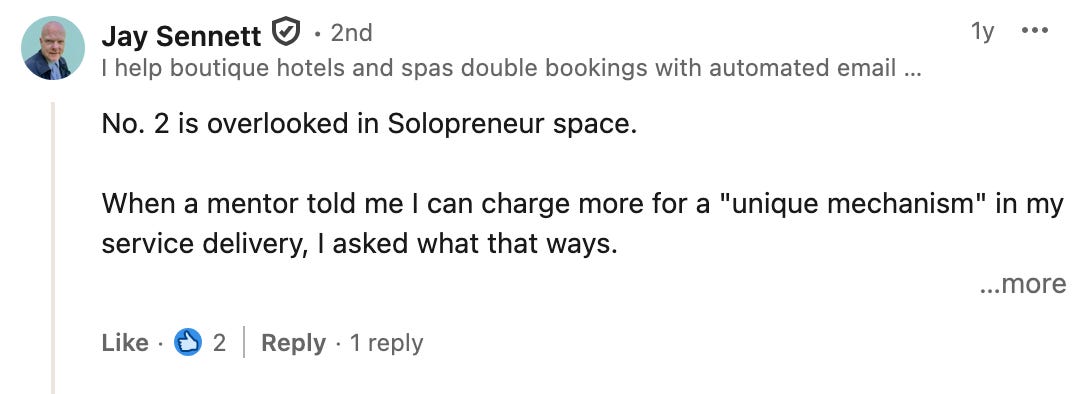

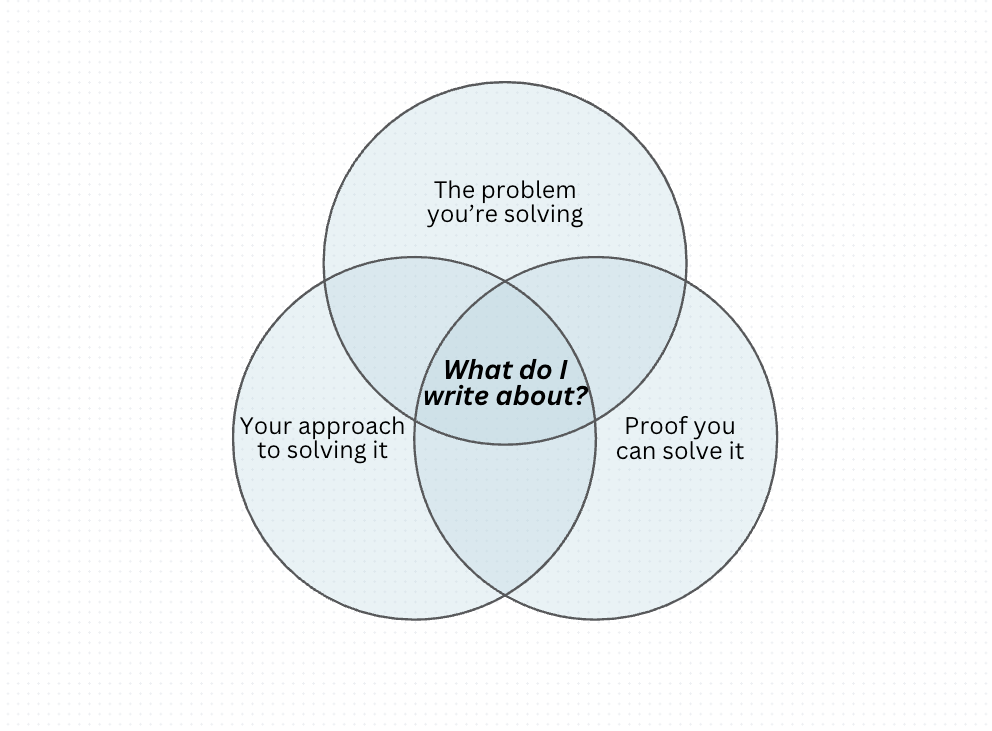
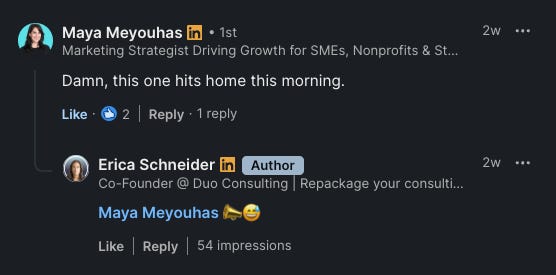
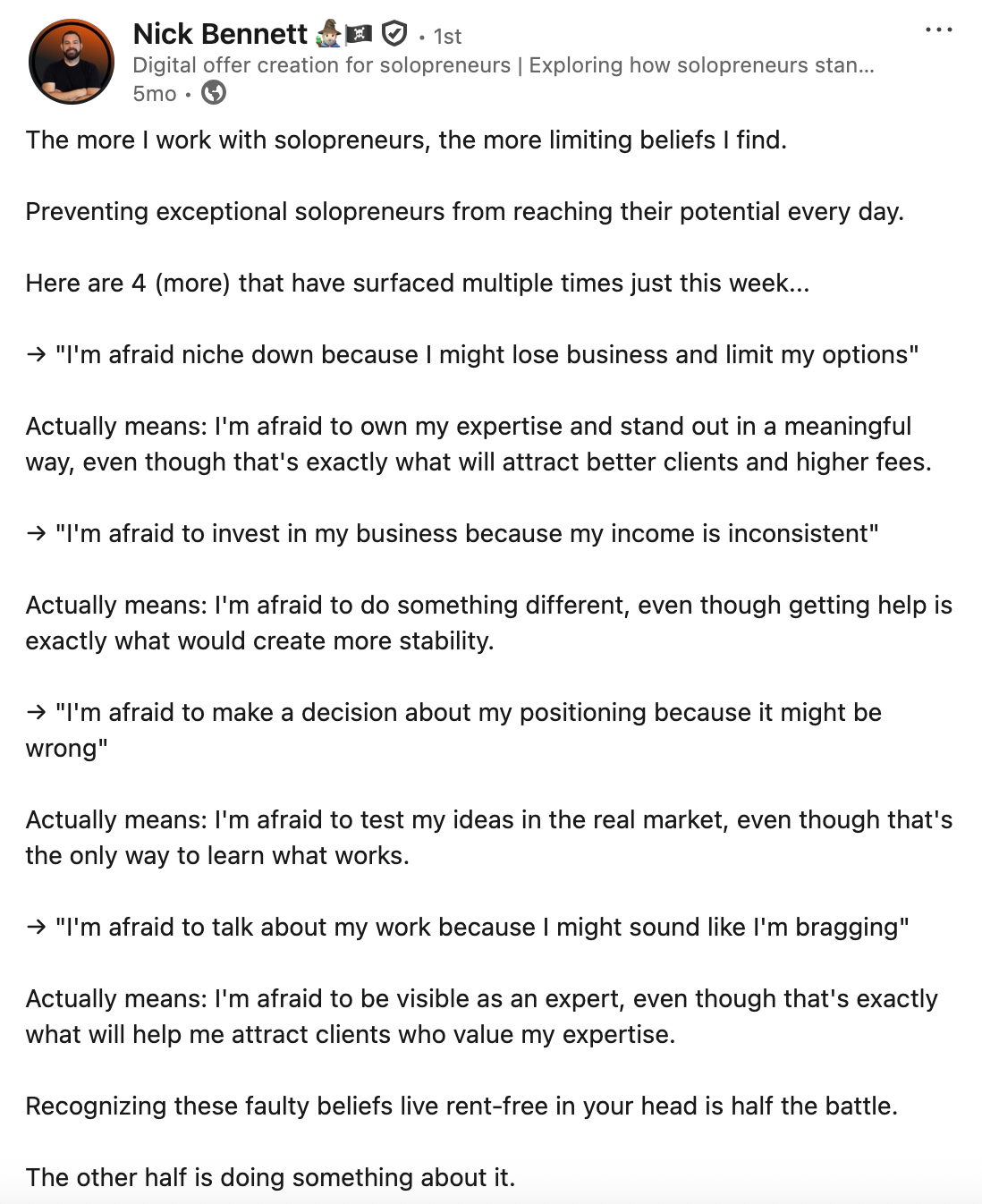
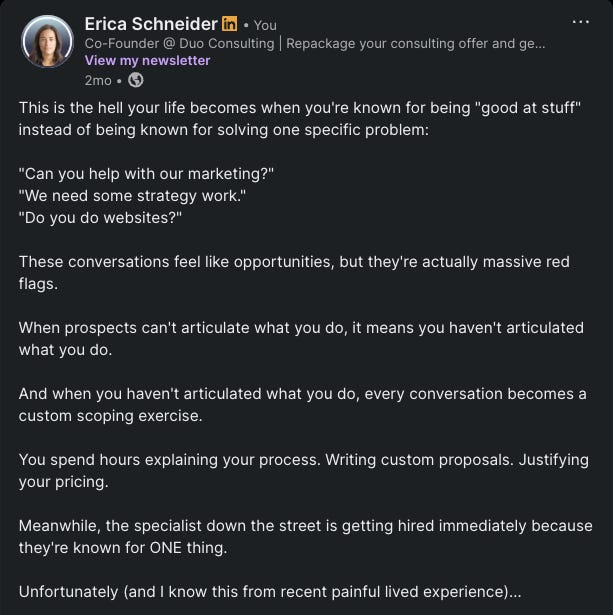
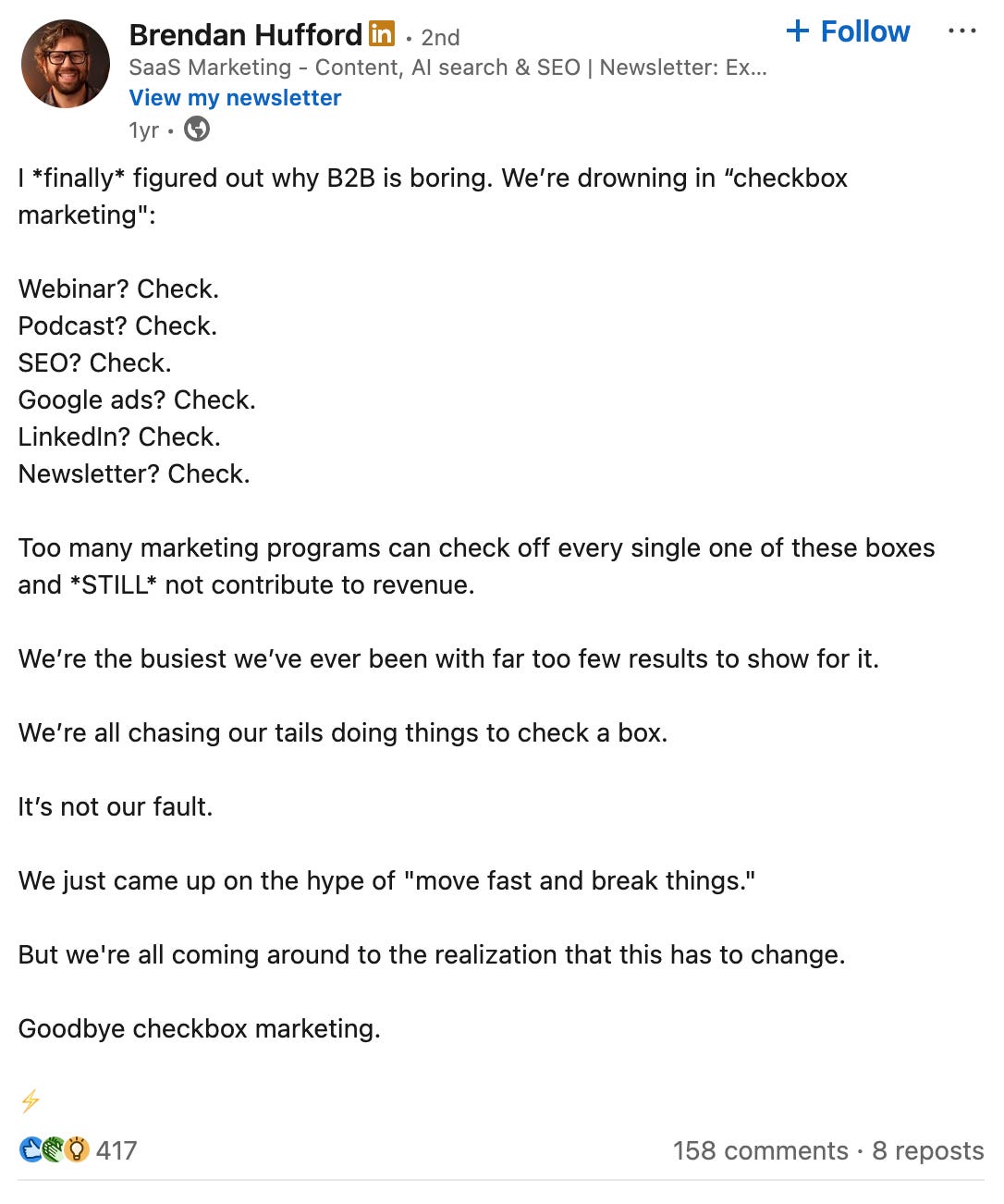
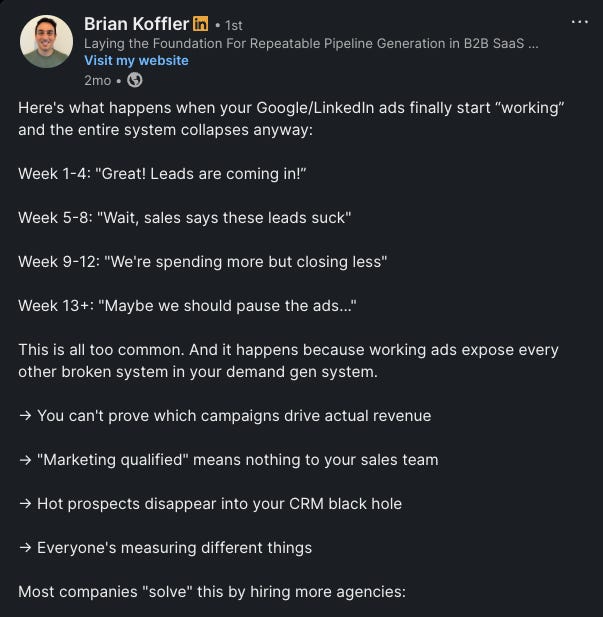
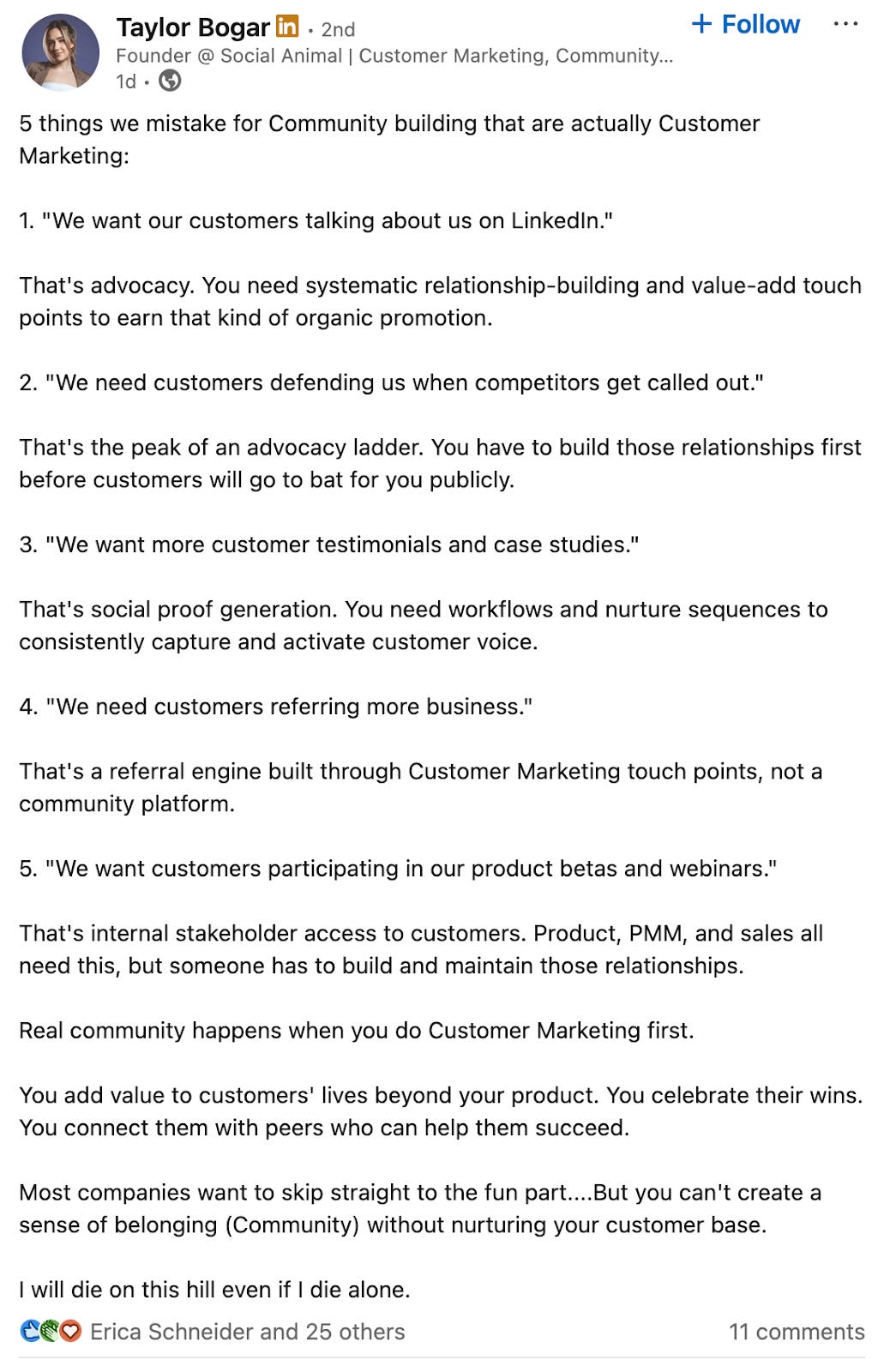
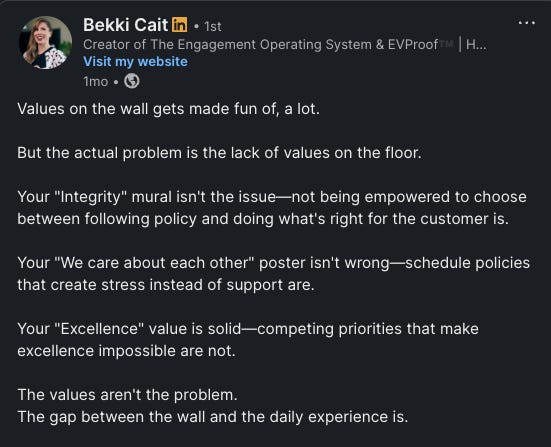
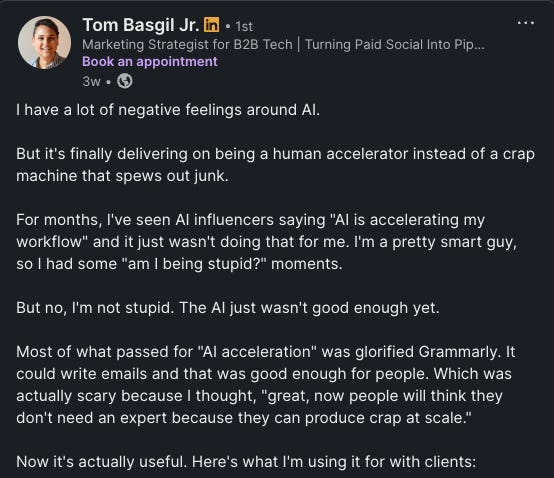

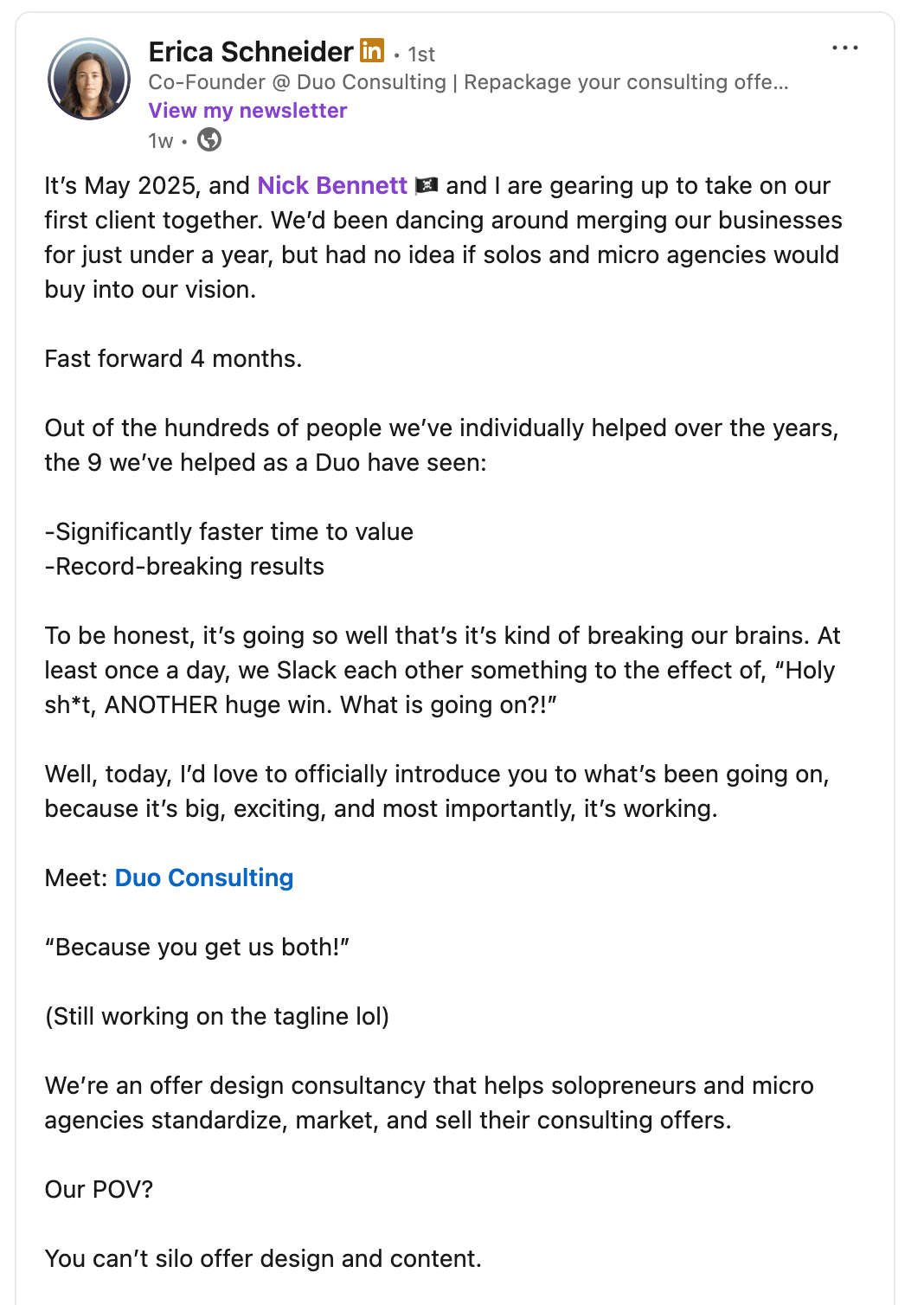
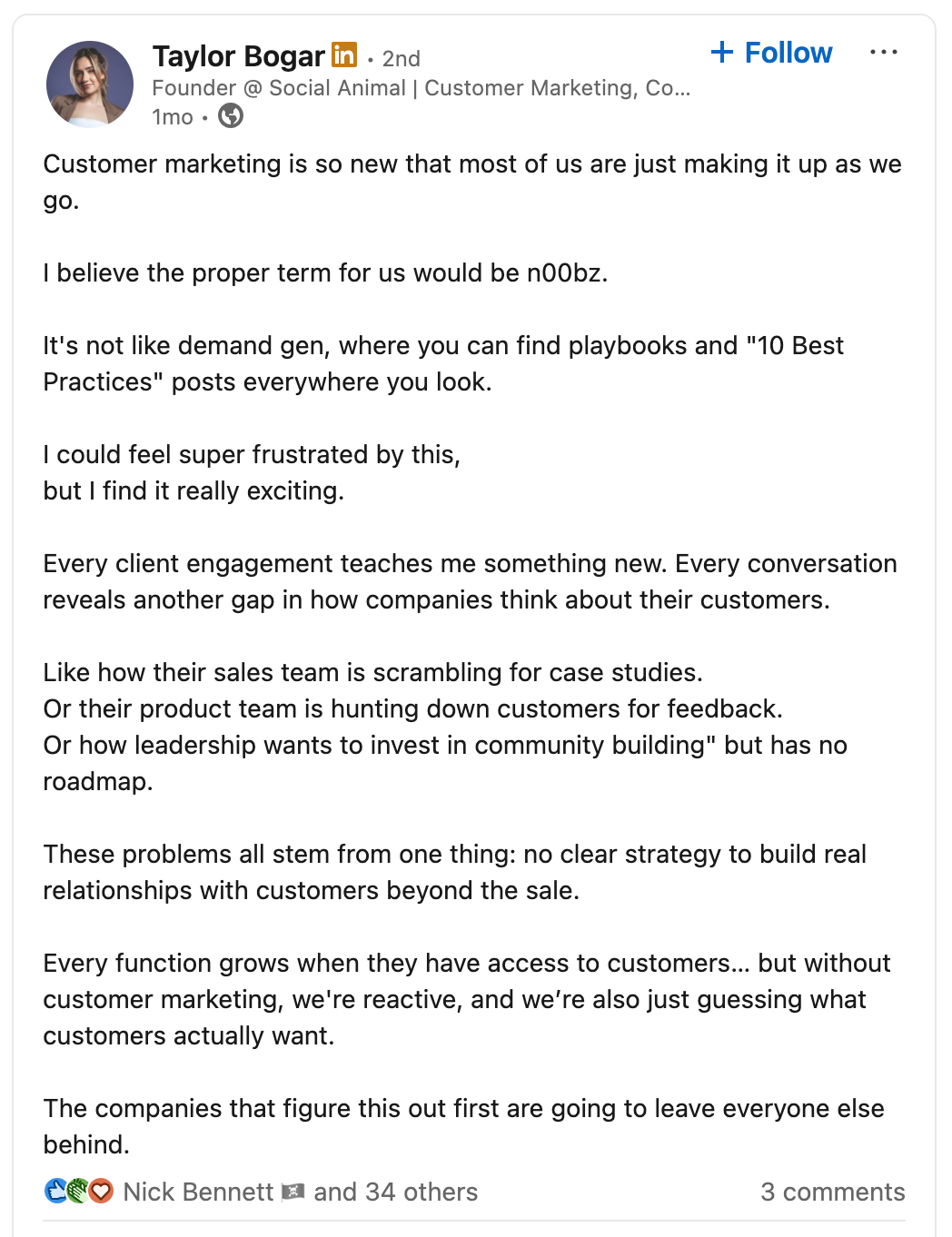
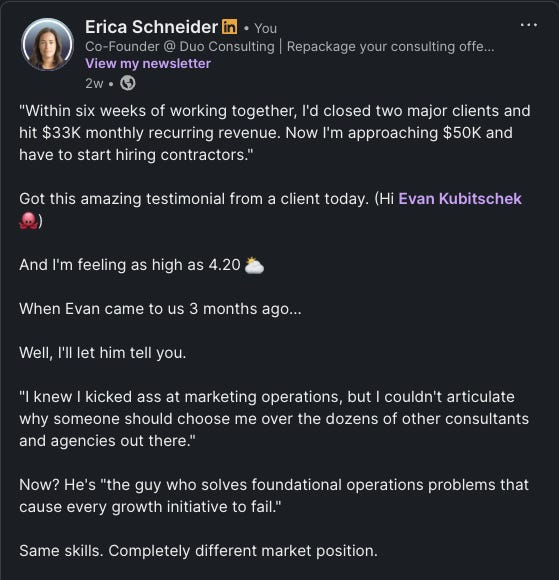

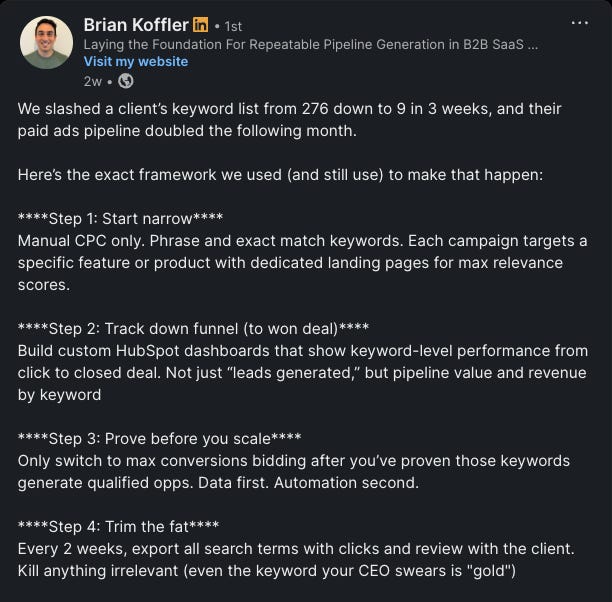
This is amazing! It's true, you have to talk about the problem you solve over and over and over in different ways to make sure that it resonates with your ideal client. You have to have a process people believe in, and you definitely need proof to show that you can do what you promise. Love this breakdown :)
Thank you for this. Wow. I'm printing it off to study it further, but damn there's so many things I am either: not doing, doing wrong or never thought about. Thank you for putting the pathway out there so clearly.